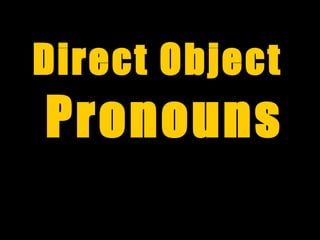Module 6 direct objects (d.o.)
•Als PPT, PDF herunterladen•
0 gefällt mir•1,517 views
Melden
Teilen
Melden
Teilen

Empfohlen
Weitere ähnliche Inhalte
Was ist angesagt?
Was ist angesagt? (20)
Ähnlich wie Module 6 direct objects (d.o.)
Ähnlich wie Module 6 direct objects (d.o.) (20)
Mehr von senorvonier
Mehr von senorvonier (20)
Module 6 direct objects (d.o.)
- 2. Direct Object Pronouns me nos te lo/la los/las
- 3. Direct Objects 1.The Direct Object is the person, place or thing that directly receives the action of the verb. S + V + who or what = direct object Subject Verb D.O. Paco needs a book.
- 4. Direct Objects 2. The Direct Object will only be represented once in a sentence, either with the noun or the pronoun - never both. Paco is buying a book for Marta. Or Paco is buying it for Marta.
- 5. Placement •If it is the object of conjugated verb - then place it before the verb. ie… Marcos lo come •If it is the object of a verb infinitive - then you can attach it to the end of the infinitive or place it before the conjugated verb. ie…Marta quiere comerlo. Or Marta lo quiere comer.
- 6. Examples Paco has a book in his backpack. Paco tiene un libro en su mochila. Paco has it in his backpack. Paco lo tiene en su mochila. *If a direct object noun is used in English, then a direct object noun will be used in Spanish. If a pronoun, then a pronoun.
- 7. Preguntas 1. Where do you place the direct object pronoun if it is the object of the conjugated verb? In front of the conjugated verb
- 8. Preguntas 2. Where do you place the direct object pronoun if it is the object an infinitive? Either before the conjugated verb or attached to the end of the infinitive
- 9. El Fin
- 10. El Fin
Hinweis der Redaktion
- Object of conjugated verb- before verb
- Object of conjugated verb- before verb
- Object of conjugated verb- before verb
- Object of conjugated verb- before verb